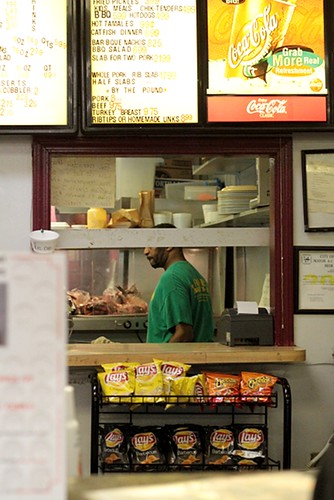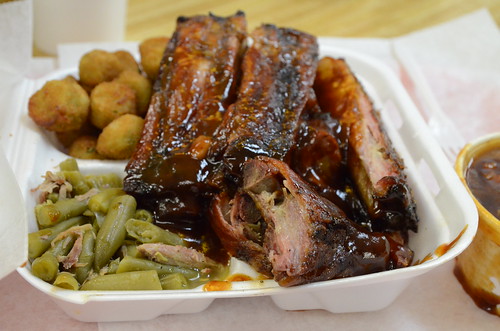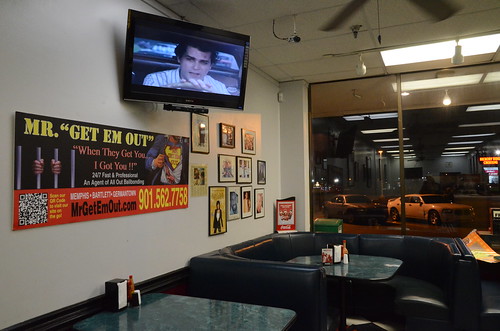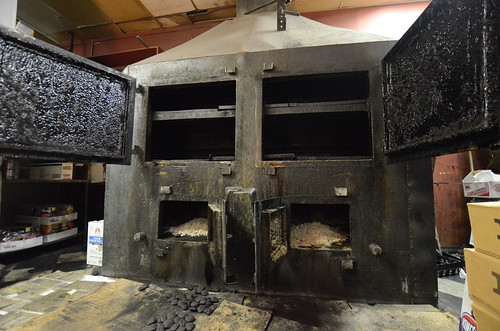Or, The Wisdom of Craftsmen: A&R Bar-B-Que, Hickory Hill, Memphis
In March 2013 we spent a week embedded in Memphis, befriending the locals while hitting the bars, music venues, and barbecue joints in order to get a true sense of the city, its people, and its culture.
“What the hell were you doing there?”
“You were in the ghetto!”
“Huh? Never heard of them.”
Every time we raved about A&R Bar-B-Que, this is where the conversation would go. ![]() When you’re driving around Memphis for a week, eating as much barbecue as you can, every conversation starts with the same question: “What are the best ribs you’ve had yet?” I would respond the same way each and every time: “A&R’s”
When you’re driving around Memphis for a week, eating as much barbecue as you can, every conversation starts with the same question: “What are the best ribs you’ve had yet?” I would respond the same way each and every time: “A&R’s”
“What? Where’s that?”
With my knowledge of Memphis geography still developing, I’d say, “It’s on Hickory Hill?” Then we’d get “Ghetto!” responses like the ones above, even though the area really didn’t seem that rough to us. Either way, the ribs were worth the trek. Given the quality of the barbecue at A&R Hickory Hill, the very traditional smoking method employed, and the stalwart pit leadership, we couldn’t believe that no one we met had ever been there before.
We’d read about the local A&R chain while researching the trip, mostly on Memphis Que. I have no idea how we ended up at the Hickory Hill store; Dan just had an address and a phone number in his binder of notes. After we consumed our first dinner of the night, we were looking for a place that would be open late. Dan called the number for A&R, and whoever answered the phone said they’d be open another hour. Boom: Dinner Number Two.
So we headed to Hickory Hill Road from South Memphis, skirting the perimeter of Memphis International Airport, driving around a gigantic train yard where towering gantry cranes moved shipping containers around under sodium-vapor light, and past a Best Western that we recognized from another Memphis Que piece — the hotel’s restaurant also serves ribs, likely to hungry train crews.
At first, we drove by the Hickory Hill A&R without noticing it. That particular outpost occupies the left-most spot in an aging, L-shaped strip mall, across from the sprawling, multi-acre Big Daddy’s Pawn Shop (aka bigasspawnshop.com). We turned into the deserted mall, which looked so generic and rundown that we could have been back in blue-collar Queens, and drove the entire length of the parking lot. When we got to the last storefront in the building, we had found A&R. Two tricked-out Dodge Chargers sat out front. Only the letter Q in A&R’s sign was illuminated.

Inside, the decor was decidedly utilitarian. A huge ad for “MR. GET EM OUT,” a bail bondsman, had been printed on a foamcore sheet and mounted on the dining room wall. It read: “When They Get You… I Got You!” Above this indoor billboard, Goodfellas played on a flatscreen TV. As we contemplated the menu boards, which offered an intriguing mix of barbecue and soul food, Ray Liotta’s coked-out Henry Hill was just starting to get really paranoid about that helicopter following him around.
We had the place to ourselves, so we took our time. The front counter lady — I believe her name was Shawanda — did not rush us along. By that point of the trip, and after we’d had some especially mediocre Memphis pulled pork, we decided that ribs would be the standard of comparison for Memphis barbecue restaurants. However, we hadn’t seen rib tips on a menu before, so we debated: the rib or the tip? Shawanda waited patiently. We decided on a plate of tips, requested hot barbecue sauce on the side, and added sides of green beans and fried okra to the order.
Big styrofoam cups of sweet tea appeared, bearing the A&R motto: “ANYONE CAN PUT THE HEAT 2 THE MEAT BUT ONLY A FEW CAN BAR-B-QUE.” Drat: the tea was “pre-lemonated,” a phrase I picked up from one of the barbecue blogs. A Goodfellas-filled intermission ensued. As things got worse for Henry Hill on TV, we waited to see if Hickory Hill’s barbecue would live up to the cup’s hype.
Without warning or announcement, our tray of food was placed atop the counter. My heart sank when I saw that the sauce had been liberally applied to the… ribs? Rib tips? There were both! Did the kitchen staff use their telepathic abilities to know that we really wanted to try each rib variation? We had gotten exactly what we wanted, even though it wasn’t what we ordered.
Flashes of beautiful, pink smoke ring popped out at us where the meat had been sliced, competing with the sheen of the sticky sauce for our attention. The battered okra appeared round and succulent; the green beans had been boiled with chunks of pork, adding both an appetizing appearance and, as we soon found, some truly fatty flavor.
As we gazed upon this bounty, Shawanda came over to say that she’d prepared a side of beans for a take-out customer who no longer wanted them; would we mind eating those, too? Of course not. The feast began.
Because it was all over everything, the barbecue sauce was the first thing I tasted. And it was seriously hot despite its sticky appearance, which usually connotes sweetness. This pleased me; I’d have used it even if it had come on the side. Sauce tragedy averted.
(Let me explain why the sauce made me nervous. In the northeast, “BBQ” meats are often boiled and/or grilled, then slathered with corn-syrup “barbecue sauce.” This perpetuates the myth that pouring sauce on anything can magically turn it into something else. “Boiled ribs? Now they’re barbecue!” “Don’t like carrots? Now they’re ranch carrots!”)
Even though our A&R plate came with plenty of sauce, the ribs and tips were the smokiest we’d had yet, and they remained plenty moist. That’s one of the biggest challenges of barbecue, balancing flavor and moisture. I even tried scraping the sauce off the meat to see if maybe, just maybe, some kind of fake smoke flavoring was coming from the sauce. It wasn’t. I couldn’t tell just what kind of fuel had been used, but these ribs had been smoked; that much was unmistakable.
At A&R, the barbecue ribs and the barbecue sauce were their own separate entities, with their own distinct personalities, working together. In fact, the ribs’ smokiness and the heat of the sauce made A&R my favorite Memphis rib experience, a title that would hold up over the course of our week there. (And, to be fair, I rarely order ribs, but I had at least four near-religious rib experiences during the MEMPHQ trip.)
The unique smokiness of these A&R ribs also made me very curious about what was going on in the back-of-house. So, on my way to the restroom, I peered into the kitchen through an open door.
What I saw intrigued me: a mammoth, metal smoking pit, painted flat black, with a funneled chimney pointing up through the ceiling. Its four heavy metal doors were latched shut, so I couldn’t tell if anything was cooking just then. The whole thing looked like a bank vault from a Dick Tracy movie; it looked a hundred years older than the strip mall itself. Had the mall been built around this formidable smoker?
Now I was determined to tour the kitchen.
Back up front, Dan was finishing his meal and photographing the man moving about behind the counter: a well-built, middle-aged, African-American gentleman with tattoos running up and down his arms. This was Dave Lloyd, pitmaster.

I can’t remember what got the conversation started. It was probably the cameras (it’s always the cameras.) At any rate, I asked Lloyd what he was using in the pit.
“Straight charcoal,” he responded.
That’s when it clicked: most North Carolina joints use oak and hickory wood; most Texas joints mesquite and post oak. The Memphis joints seem to mainly smoke with charcoal, often briquettes as opposed to lump. Some use a local brand; others seem to use the national brands that people use for backyard grilling.
(In A&R’s kitchen I noticed a bag of Kingsford briquettes. B’s Barbecue in Greenville, NC is the only other joint I know that also smokes with Kingsford, using it to make very famous East Carolina pork and chicken.)
I asked Lloyd about seeing the kitchen, and he invited us to meet him at the door I’d just been peering through. On the other side of the door, the restaurant was being put to bed for the night. The stainless steel surfaces gleamed, and cardboard boxes of cracklins — fried pork skins — waited to be served to customers the next day.
Lloyd explained that A&R makes everything in-house, including the cracklins. He opened the smoker’s four doors to reveal cooking racks a few feet above the firepit, which was laden with ash from the day’s work. This didn’t look like anything we’d seen anywhere else, as many Memphis restaurants use more “modern” equipment like partially-gas-fueled Southern Pride and Old Hickory smokers. And some of those places — even the famous ones — go heavy on the gas, light on the wood or charcoal. The difference in flavor is staggering.
As we chatted with Lloyd in the kitchen, he seemed happy to hear we were visiting from the Northeast. He had actually moved to Memphis from Southeast, DC 30 years ago. Over that time, he learned the Memphian barbecue craft from his uncle by working summers at Pollard’s, where we had consumed that night’s Dinner Number One just a few hours earlier.
“When I first moved here,” he said, “It took me a few weeks to get used to people talking to me,” then feigned his shock at people greeting him on the street. We got the regular admonition to be careful on the streets of Memphis, which we received from pretty much everyone we met there, “but you’re from New York.”
Before we hit the road, Lloyd asked us our opinion of his barbecue. We gave our honest assessment: best yet. He smiled, but he didn’t seem flattered. Instead, he might have been just a little embarrassed. As he put it:
“I gave y’all some ribs because I thought the tips were dry — that’s not our usual product. I wouldn’t want someone to walk in here once and think the tips were dry… It’s quality over quantity.”
We thought he had done great work, but he thought he could do better. That craftsmanlike drive toward quality in turn inspired his generosity. When we placed our order with Shawanda, Lloyd wouldn’t have had any idea who was out front — a regular from around the corner or two strange, camera-wielding dudes from far away. But he wanted us to experience the best his restaurant had to offer.
The leftovers came home with us and took their rightful place in our hosts’ fridge. Almost every remaining night of the trip, when we got home from the bars around 4am, I’d gnaw on a rib to see if it was as good as I remembered. A&R’s ribs never let me down, thanks to the skill, wisdom, and generosity of a craftsman.
Text: Rob Bellinger
Photos: Rob Bellinger & Dan Meade
Date of visit: March 25, 2013
Date of publication: June 3, 2013



